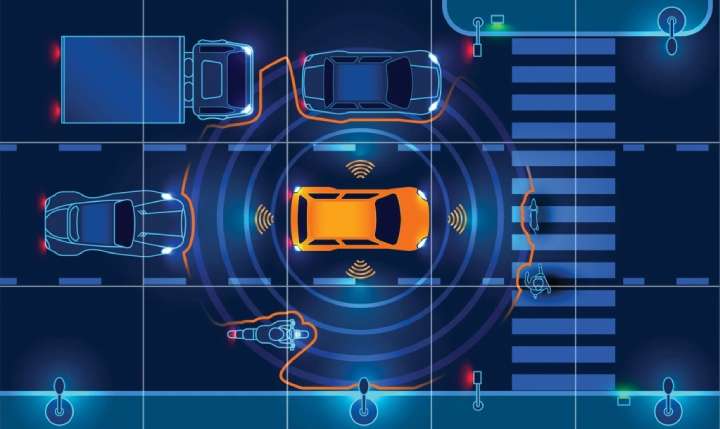ALEXANDRIA, Va. — Satellite connectivity is being leveraged more and more for uses from agriculture and logistics to energy and transportation, as new solutions and network architectures enable verticals to work together effectively. Within that context, autonomous vehicles are emerging as an attractive niche where satellite technology can shine.
 Satellite-based content connectivity provider NOVELSAT and software solutions developer Guident teamed up for a remote monitoring and teleoperation solution for autonomous vehicles.
Satellite-based content connectivity provider NOVELSAT and software solutions developer Guident teamed up for a remote monitoring and teleoperation solution for autonomous vehicles.
In late February, NOVELSAT announced a new partnership with Guident, a software provider for remote monitoring and control of autonomous vehicles. The solution provides continuous high-quality video and audio streaming with bi-directional, satellite-enabled connectivity for remote monitoring and control of autonomous vehicles.
“The underlying motive is to improve the safety in order to go to market, to remove this hesitation that people have today when they’re thinking about autonomous vehicles,” Aviv Ronai, Chief Product and Marketing Officer at NOVELSAT told Constellations. “With this, we can guarantee the safety of autonomous vehicle fleets…and show that no matter what happens, everything can be monitored and controlled.”
The announcement came at a critical point for the autonomous vehicle market. Several projections have estimated that market will exceed $1 trillion by next decade, encompassing various levels of automation from driver assistance to full autonomy. However, some of the more ambitious timelines that product developers had previously set are colliding with the needs to reach that goal safely. According to a recent KPMG survey, a growing number of global automakers have pushed out their expectations for fully autonomous vehicles to hit the market to beyond 2030 and 2035. This comes amid reports and scrutiny of incidents involving vehicles on autopilot, as well as shifting investment priorities from full autonomy into more practical, supporting features.
“What we see even more is some need for human intervention in some cases, like emergencies,” Ronai said of the road to full autonomy. “Currently, those solutions rely on a mobile network and are therefore confined to a limited space. But if you want to think larger scale deployment to travel distances, then you have to ensure always-on connectivity.”
A connection to a satellite network ensures that the autonomous vehicle is not relying on a single point of connectivity, like a cellular or mobile network that may be unavailable outside population centers, or inaccessible because of network congestion, outages or emergencies.
“This is exactly where we come in,” Ronai said. “In this regard, we are complementing the cellular network, making sure the connectivity is always on. So, eventually there could be a human intervention at any point of time and any place when needed.”
Addressing the Challenges of Autonomous Fleet Management
Guident provides software solutions to “bridge [the] gap” to full vehicle autonomy by ensuring a human operator can observe and intervene in situations. These teleoperation systems include very low-latency multi-camera streaming and cloud-based software accessible by remote control operators. It’s expected that human-in-the-loop AI technologies will be a part of the AV landscape for the foreseeable future as autonomous vehicle regulations and the market matures.
 Demand for a human-in-the-loop solution will remain high as the automotive industry takes gradual steps toward fully autonomous vehicles. (Source: NTSB.gov)
Demand for a human-in-the-loop solution will remain high as the automotive industry takes gradual steps toward fully autonomous vehicles. (Source: NTSB.gov)
NOVELSAT will provide high-capacity satellite modems to link the autonomous vehicle to a satellite constellation in GEO or LEO, utilizing an electronically steered flat panel antenna installed in the vehicle. The satellite modem incorporates a bandwidth-efficient waveform to support real-time video and audio connectivity to monitor situations, enable remote driving and communicate with passengers, pedestrians and first responders during unpredicted situations.
Latency continues to be one of the challenges for satellite operators, particularly in operating environments that require immediate action. According to Ronai, the NOVELSAT solution will be capable of working with both LEO and GEO satellites. The company is also reportedly working on the means to mitigate latency from GEO.
The other challenge is providing cost-effective connectivity to teleoperate a fleet of vehicles constantly and in real time. “Satellite capacity isn’t cheap. So, you want to be as efficient as possible,” Ronai noted. In this case, NOVELSAT employs real-time allocation of bandwidth and network resources to vehicles based on the particular needs of a particular vehicle.
“You don’t need to keep high-capacity links to each vehicle all the time. You need to keep minimal capacity to each vehicle and enough capacity to enable teleoperation of some,” he continued. “So when a vehicle does require the human in the loop, you allocate this capacity in real-time and enable this teleoperation.”
Working Across Industries
The integration of non-terrestrial networks into 5G has opened new possibilities for satellite connectivity. Use cases are cropping up for operators to leverage New Radio specifications for 5G, particularly for narrowband solutions, such as satellite IoT and direct-to-device connectivity. For broadband applications, companies like NOVELSAT have developed their own solutions to support high throughput links.
“This is really complimenting the 5G network with the satellite network,” Ronai said. “We are working as a parallel network to 5G and we are switching between those networks because it’s really a kind of extension.”
 Autonomous vehicles will need to leverage hybrid networks, switching between mobile and satellite connectivity.
Autonomous vehicles will need to leverage hybrid networks, switching between mobile and satellite connectivity.
This idea of a seamless hybrid network is critical for mobility and communications-on-the-move, like tracking, maritime and in-flight applications as well as autonomy. When a device is in range of a cellular network and gets sufficient bandwidth, it can use that connectivity. It can also switch over to a satellite link when the terrestrial connectivity is poor or unavailable, ideally without the end user noticing any difference.
One of the ongoing challenges in the satellite space is finding ways to integrate products and services across industries. There is a lot of talk about ways to leverage satellite connectivity across different industries, but there is still a gap between the development and real deployment of capabilities.
“It always takes time,” Ronai said. “Autonomous vehicle and human in the loop is an industry in its infancy, relatively. It can take many shapes and forms and we’re all figuring this out as we move forward with the different projects.”
Developments in the satellite-connected vehicle and equipment space have started picking up over the past year. In late 2022, John Deere announced a request for proposal for a satcom solution to outfit its fleet of tractors with always-on connectivity as a precursor to autonomous farming. More recently, the Chinese electric vehicle manufacturer Geely announced a new line of vehicles that it plans to integrate into the satellite constellation it began deploying last spring. Geely currently has nine satellites in orbit and plans to deploy up to 72 by 2025 to support navigation, positioning and intelligent driving features.
Explore More:
BCG Space Exec Explains Growth Trend for Value-Added Space Services
Podcast: Future of Satellite Connectivity, New Applications and 2023 Space Trends
Qualcomm Looks to Develop Direct Satellite-to-Smartphone Broadband Links
